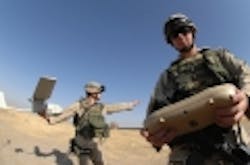Advanced helmet-mounted sensors that measure IED blast effects on Army soldiers to be built by BAE Systems, Allen-Vanguard
NATICK, Mass., 4 July 2010. U.S. Army researchers are asking two defense contractors to design and build advanced helmet-mounted sensors that measure blast trauma to soldiers inflicted by roadside bombs. These sensors compile blast data to help save troops from battlefield head injuries by improving helmet designs, other protective clothing, and other ways for the Army to prevent and mitigate blast effects on soldiers from improvised explosive devices (IEDs).
The Army is awarding a $17 million contracts to the BAE Systems Security & Survivability segment in Phoenix, and to Allen-Vanguard Corp. in Ashburn, Va., to design and manufacturer the Generation II Helmet Sensor to record concussive forces such as helmet acceleration and blast pressure. The sensors will be mounted beneath the pad in the crown of the Advanced Combat Helmet.
Data captured by the Generation II Helmet Sensor not only will help define the threat of head injuries from IEDs for developers of soldier protective equipment, but also to develop a detailed model of how the helmets and helmet pads distribute and cushion external pressures on the helmet, Army officials say. Awarding the contracts are researchers at the Army Research Development & Engineering Command in Natick, Mass.
The Generation II sensors add wireless capability to download data without plugging the sensor into a USB port, as is the case with Generation I Helmet Sensor. The second-generation sensors also will help researchers retrieve information wirelessly on the sensor's power consumption, remaining memory, and overall functionality.
The Generation II sensors are smaller in size, weigh less, and have one year of rechargeable battery life, versus six months now for the first-generation sensors, and will retain USB capability for downloads and recharging.
For more information contact BAE Systems Security & Survivability online at www.baesystems.com, Allen-Vanguard at www.allenvanguard.com, or the U.S. Army PEO Soldier at www.peosoldier.army.mil.
